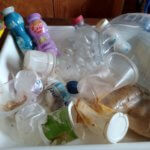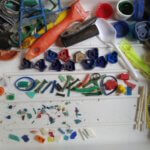PLASTIC FREE FEBRUARY
Plastic is a wonderful material, it is resistant, malleable, durable – and cheap compared with other materials on the market. Over time, it has become the most used material, especially with regard to home and personal items. Since 1950, more than a tonne of plastic has been produced for every person alive today*1. With consumption comes waste, and here, the characteristics of plastics have a negative effect. It is very resistant and slow to degrade. It has become the most discarded and dumped material in our rivers, soil and seas. More than 150 million tonnes of plastic has already entered the oceans and another 11 million tonnes will end up there each future year, with almost 1,000 marine species known to be contaminated by the waste*2. 
Each year one hundred thousand marine mammals and millions of birds, fish and turtles lose their lives because they inadvertently consume or are injured by plastic and microplastic. Humans too are being threatened by the harm of microplastics found in different food products such as salt, fish and seafood. Scientists who examined tissue samples taken from lungs, liver, spleen and kidneys found traces of plastics contamination in all of them. This included polyethylene terephthalate, which is used in products such as plastic drinks bottles, as well as polyethylene, which is used to make plastic bags*3. 
Our governments, responsible for laws and regulation, are already making an effort to stop this problem but we, both individually and in our community need to do our part too.
*1/*2 Source: The Ellen MacArthur Foundation and WWF, environmental charities that produced the report
*3 Source: Varun Kelkar, Illinois’ University
A Rocha’s project
A Rocha is launching a project called Plastic Free February and its purpose is to reduce the amount of plastics we use. We will do this, as much as we are able, by monitoring and reducing our personal use of plastic at home. We know it will be a difficult task but we are hoping that everyone can share, not only the difficulties you faced but also the solutions and tips you found both practical and feasible. We want to use our blog, Facebook and Instagram pages to share both.
Here are some suggestions:
To be able to know if we are reducing the use of plastic, we first need to know how much plastic we are currently using. For this we need to select and separate our plastic rubbish from other rubbish. Then we need to measure the plastic rubbish we have used during the first 28 days of January. This can be done in three ways, you can choose the one easiest for you;
- By weighing our plastic rubbish (bags)
- Or if we don’t have a scale, registering the volume (how many litres does your plastic rubbish bag hold) multiply by the number of bags we put in the rubbish.
- Use a chart (we have made one available to download), put it next to the bin or on your fridge and register how many plastics items you throw out.
In February we plan to do the same exercise using the same measurement (kgs or litres or chart) that we used in January. You may use any other method that is easier for you.
Tips for starting:
- Look careful at labels, some of the personal products like body creams and gels are full of microplastic. Try to avoid them!
- Use your own cloth bags when buying your vegetables and bread. Nowadays you can buy vegetables without using a plastic bag, weighing them at the checkout and using your cloth bag to take them home.
- Avoid double packaging! Biscuits, cookies and some other products come in small bags. Avoid those!
- Try to buy a detergent that can clean windows, counters and ovens, instead of buy 3 different ones. Also for bathroom products.
- Every time you can, buy products in a glass bottle instead of in a plastic bottle
- Research on-line for other tips.
In general
Reduce your consumption, Re-use what you already have, Refuse to accept what you don’t want, Recycle what you can’t use anymore
Please join us, even if you are not registering how much you reduce.
Do send us small videos with ideas, tips, solutions that you found and also your difficulties. We want to share those on our blog. You can make the films in English or Portuguese.
Isabel Soares